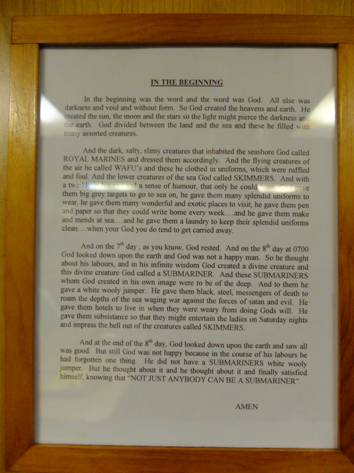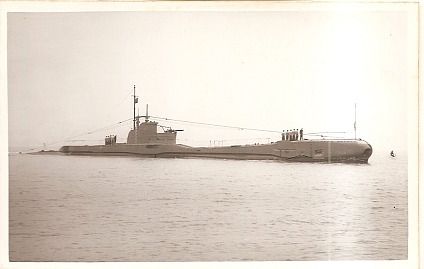Submarine Stories
Submarine Stories
This page is a collection of submarine stories, dits, history, tactics and strategy. It is collected from a wide variety of sources, and is meant to become an archive of underwater life in peace and war (and in cold wars too).
We welcome contributions from submariners or historians. If you have something to contribute contact us using the “contact us” page. We don’t pay for contributions, but will of course credit and link wherever we can.
The Lazaretto at Malta
The History of submarining
The early history of submarine development during the 19th century is much longer than expected. Dozens of schemes were conceived and many built. That history is described with great thoroughness and an easy style by Dr Mike Dash in his doctoral thesis here.
Here is a Pathe video from 1942 of submariners training in N23...www.britishpathe.com/video/submarine-crews-in-training/query/submarine
Submarine accidents and disasters
In the words of one veteran submariner (Commodore Eric Thompson RN MBE, in his outstanding memoir On Her Majesty's Nuclear Service), life in submarines is one long attempt to avoid being blown up, gassed, electrocuted, scalded, crushed, drowned, suffocated or boiled alive, and that is just in peacetime. Submarines are surprisingly dangerous places to be even at the best of times.
Living with ever-present lethal danger, submariners come to view the rest of the world with some disdain, as this extract from the submariners' bible suggests:

The loss of USS Thresher
Thresher was a nuclear powered attack submarine (an SSN) designed to act as a hunter-killer of other submarines, With a submerged displacement of 3,420 tonnes she was launched in 1960.
In April 1963 Thresher was conducting post-refit deep diving trials 200 miles east of Boston. She was circling below the surface rescue ship Skylark, diving an additional 100 feet on each circuit to her test depth of 1,300 feet. She was in contact with Skylark on her underwater telephone. These units are notoriously unreliable.
At 0825 Thresher was at 1,000 feet. She continued to dive, moving at slow speed, probably 3 knots. At 0902 she turned to course 090 degrees.
What happened next has to be pieced together from the limited evidence, and from tests conducted on Thresher’s sisters after the accident.
At 0909 it is believed that a pipe joint in the engine room failed. At first observers thought that this was a seawater pipe, which would have quickly flooded the boat, but later analysis of declassified SOSUS data suggests that there was no seawater flooding, which would make this leak an internal leak. An external leak would have made a considerable noise, which would have been recorded by SOSUS.
What happened next is the subject of some argument. There was definitely a leak when a pipe joint failed. Thresher had 3,000 silver-brazed pipe joints exposed to seawater pressure (and probably more carrying internal pressure). Some of these were tested at random with ultrasound during her refit, and 14% were found to be defective. One of these might have given way. It is also possible that in internal pipework joint gave way.
Whichever it was (and we probably wont know), spray from the leak seems to have landed on the switch-gear for the main circulating pumps and tripped them. These are large pumps that keep water circulating through the reactor to extract heat for the steam generator. Without these pumps a reactor would quickly overheat and melt, so when these pumps go the reactor SCRAMS (goes into emergency shut-down) – which means that its control rods are immediately inserted to stop the fission reaction.
As Thresher neared her test depth Skylark received a garbled message “…minor difficulties, have positive up-angle, attempting to blow”. A second part-message was received, then silence. Thresher had sunk.
Thresher only had one reactor, so as the control rods entered the reactor core steam generation stopped, and the boat lost her main propulsion.
This is a problem. At this point in the test-dive Thresher was keeping control of her depth by “flying” on her hydroplanes and by keeping a slight up angle. Her ballast tanks are full of water, and the pressure on her hull has slightly reduced her volume, so she is negatively buoyant. As she stops she begins to sink.
The CO immediately ordered main ballast tanks to be blown – filled with high pressure air to displace the water in them, and so create positive buoyancy. External water pressure is around 40 atmospheres – 650 psi – so the 4,000 psi air in her high pressure bottles is ample to blow water out of the ballast tanks. Or it would have been, but for a new problem. The HP bottles contained excess water vapour. As air expanded rapidly into the ballast tanks it cooled (just like in a fridge) and the water froze and blocked the air flow (this effect was unknown at the time, but later proved alongside in tests in other boats).
Thresher was now in deep trouble. She couldn't blow her tanks. Her last chance was to get some forward propulsion going so she could drive herself to the surface. With rhe reactor scrammed it would take some 20 minutes to restart. Thresher was sinking at a steady rate – probably around 100 feet per minute.
At 0916 Thresher used her underwater telephone to pass a message which was garbled, but contained the words “…900 N…”. This was probably intended to say “we are 900 feet below our maximum diving depth”, or 900 feet below 1,300 feet, so 2,200 feet.
Two minutes later Thresher’s hull collapsed, at 2,400 feet. Collapse took something less than one tenth of a second, and her wreckage landed in six major pieces at 8,400 feet, where it was photographed a year later by Trieste. She collapsed some 400 feet below calculated crush depth, with the loss of all hands as well as a team of civilians from the yard.
A new paper on Thresher’s loss is about to come out, by Captain Jim Bryant USN (ret) called Thresher Disaster: New Analysis". It will be published by the US Naval Engineers Journal. A 3,000-word article based on this paper is tentatively scheduled for publication in U.S. Naval Institute Proceedings magazine.
